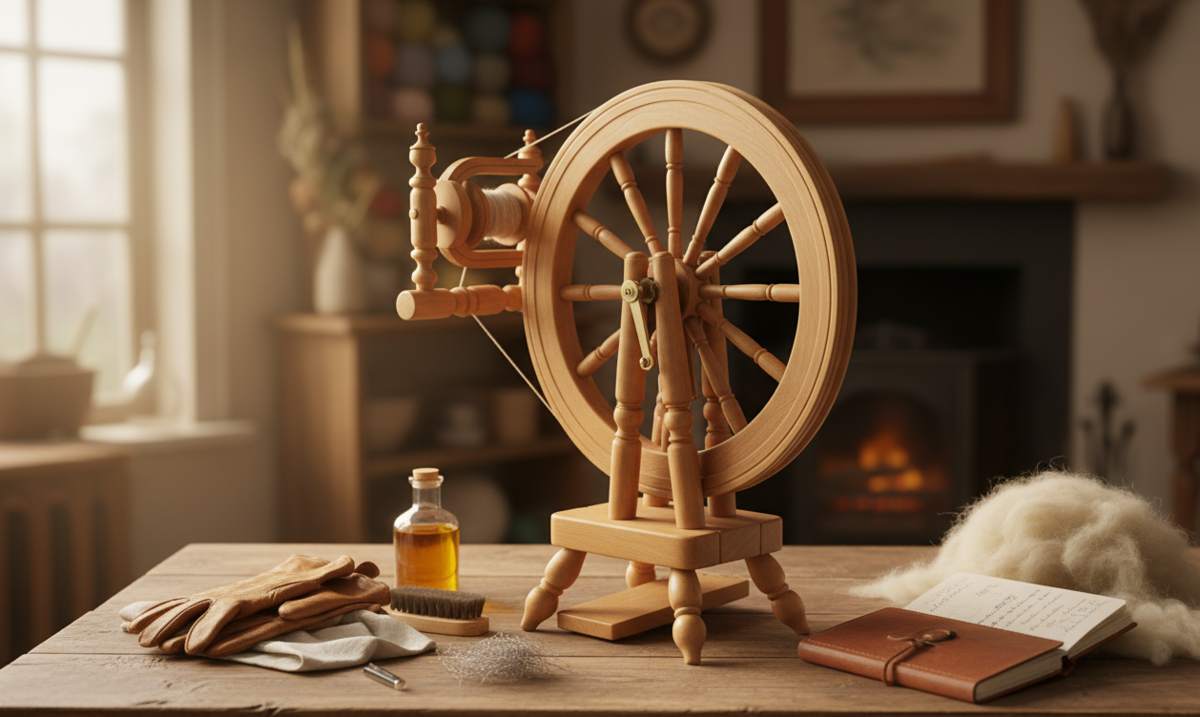Wyatt spinning wheels are beautifully handcrafted tools — custom-built with precision and quality materials. To preserve their performance, longevity, and elegance, proper care is essential. Below are practical maintenance tips and best practices to help spinners keep their Wyatt wheels running smoothly and efficiently.
Regular Cleaning and Inspection
A key part of caring for a Wyatt spinning wheel is routine cleaning and inspection. Dust, fiber lint, and small debris can accumulate, especially around the flyer, bobbin, and treadles. To prevent buildup:
- Wipe down surfaces — Use a soft, dry cloth to remove dust from the wheel rim, frame, and treadles.
- Clean the flyer and bobbin assembly — Remove the bobbin and flyer, then gently clean the spindle shaft and bearings with a lint-free rag. This helps remove abrasive particles that could hinder smooth spinning.
- Check tension and drive band — Inspect the drive band for wear, fraying, or slipping. Adjust or replace it if needed so that it tracks correctly on the whorl and bobbin without slipping.
Regular inspection helps catch small issues early before they turn into bigger problems.
Lubrication and Mechanical Care
Although Wyatt wheels are designed to run smoothly, proper lubrication ensures longevity and quiet operation. According to the builder’s own guidance, use a light, high-quality oil at key points.
- Flyer bearings: Add a small drop of oil where the flyer spindle rotates.
- Pitman arms: Lubricate the joint between the treadle crank and pitman to maintain smooth motion.
- Spindle shaft: Wipe the shaft occasionally with a soft cloth to remove grit, then reapply a thin layer of oil.
Avoid over-oiling—excess oil can attract dirt and lead to buildup that harms the bearings.
Wood Care and Finish Preservation
Wyatt wheels are often crafted from woods like Texas mesquite, cherry, oak, walnut, or pecan, and finished with hand-rubbed Danish oil. To preserve both the wood and the finish:
- Keep the wheel in a stable environment — Avoid exposing it to direct sunlight, extreme humidity, or rapid temperature changes, which can affect the wood.
- Clean with a gentle touch — Use a soft, dry cloth for regular dusting. For sticky or slightly dirty areas, a slightly damp cloth (water only) is fine, followed by a dry wipe.
- Polish occasionally — If the wheel starts to look dull, apply a small amount of suitable wood polish or a light coat of compatible oil, then buff gently to restore its sheen.
This care maintains the natural beauty and structural integrity of the wheel without damaging the finish.
Tension, Balance, and Long-Term Use
Maintaining proper tension and balance is essential for both performance and wear prevention.
- Adjust drive tension carefully — Whether using double-drive or Scotch-tension setup, check the tension regularly and fine-tune as fiber properties or humidity change.
- Balance the flyer — A well-balanced flyer reduces vibration, noise, and wear; periodically test for balance and make any needed adjustments.
- Break-in period — New Wyatt wheels may require a short “breaking-in” phase. During this time, oil points more frequently and monitor for any loose parts that may settle.
By keeping tension in check and the flyer balanced, the spinner ensures smooth, steady operation and protects the wheel’s components.In summary, caring for a Wyatt spinning wheel means combining light maintenance—cleaning, oiling, gentle wood care—with thoughtful mechanical adjustments. This approach preserves both the wheel’s craftsmanship and its spinning performance for years to come. For spinners who wish to deepen their understanding of the workspace itself — including how to set up and maintain their environment — the article “Spinning as Craft and Art: Tools, Techniques, and Inspiration” provides rich insights into the art and tools of spinning.

